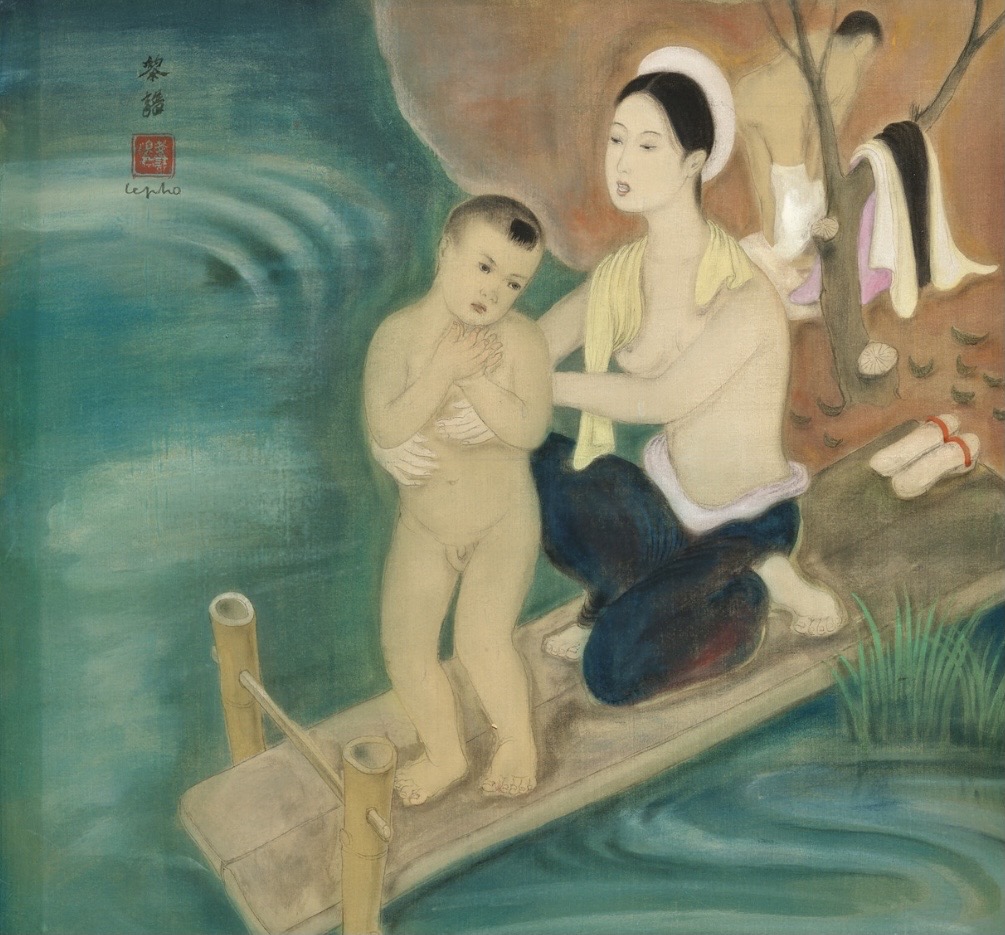Le Pho, « The Bath », circa 1938, or the instrumentalization of the nude
“Le Bain” (The Bath) by Le Pho, an exquisite gouache and ink on silk (39×40 cm), is one of the painter’s most important works.
It is an expression of his art at its peak, but more importantly he gives us, with the subtle discretion and elegance that will mark his life, his philosophy of the world.

We can date the work to around 1938. Le Pho is in the full power of his art, stimulated by his installation, voluntary and conquering, in Paris, the previous year (1937). He does not know yet that he will live there until his death in 2001 without ever seeing Vietnam again.
Le Pho offers us an outdoor scene with 3 characters.
On the somewhat phantasmagorical shore of a body of water agitated by waves, on which a wooden and bamboo pontoon is placed, a confrontation of nudity takes place. To propose it to us Le Pho chooses subtle tones of gouache, allows himself the mixtures of color, modifies his black of classic ink as the pants of the woman testify.
Three nudities: those of the child, total, of the young woman, audacious and of the third character (to which we will return), fundamental.
The child who seems to be freezing is of a realistic nudity, his hands crossed on his chest and his bust leaning towards the woman testify of the cold which seizes him.
The woman has make-up: her lips are covered with a carmine red, her eyebrows plucked, her cheeks plumped up. She wears the classic Tonkin headdress. She has left the tunic of her ao dai far away and has kept only the black pants supported by a white fabric belt. We can surreptitiously glimpse a breast. Her shoes are curiously oriented in the opposite direction of the pontoon. They correspond to the new model of shoes which is imposed in the 30s, in the Vietnamese bourgeoisie. Made of a light wood, the Wrightia Annamensis, they give the modern Vietnamese woman a more aerial gait, complementary to the grace of the new ao dai created with undeniable success by the painter Nguyen Cat Tuong and promoted by Le Pho.
The character at the top is the least visible of the three.
Yet it is he who gives a particular meaning to our painting…
Let us observe his hairstyle, the rough shape of his body, his gesture. Le Pho makes it certainly allusive almost hidden by the tree on which are hung the clothes of the group. This man is naked. A revolution in the work of Le Pho because, subject to inventory, he is the only adult man represented naked by the painter.
The painter does not give us any indication of the relationship between the different protagonists. Yet this is essential for the full understanding of the work. Are they brothers and sister? A mother with her two sons? The father, the mother and their child? Strangers to each other? In the Confucian context in which Le Pho had been educated, this nudity from a societal point of view, if it is acceptable for the child, remains shocking for the woman and unimaginable for the man. We will never know the original intention of the artist. But what we must remember is the true cultural and political transgression that he expresses here.
Le Pho was a sympathizer of the “Tu Luc Van Doan” (Autonomous Literary Group), a progressive Vietnamese nationalist movement whose theses he espoused. This movement was created in 1932 and four (Nguyen Tuong Tam, Nguyen Tuong Lam, Nguyen Gia Tri and Nguyen Thu Lê) of the seven founding members were graduates (two without diplomas) of the “Fine Arts of Hanoi“.
The emancipation of women, the refusal of the social anonymity of bodies participated in the values of this movement.
Le Pho will translate this cultural nationalism not into political nationalism like his friends who remained in Vietnam but into artistic nationalism imported into France. A painting is also a manifesto.
“Le Bain”, a magical work, bears witness to this.
Jean-François Hubert